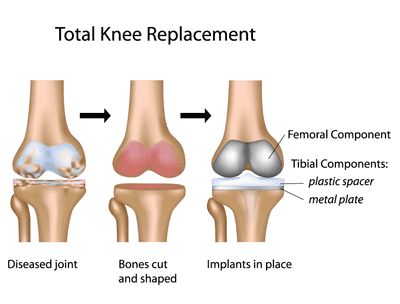
Postoperative knee replacement exercise
July 16, 2021
Admin
The most common indication for a primary knee replacement, TKA, is Osteoarthritis. Osteoarthritis causes the cartilage of the joint to become damaged and no longer able to absorb shock. Risk factors for knee osteoarthritis include gender, increased body mass index, history of a knee injury. Pain is typically the main complaint of patients with knee osteoarthritis.
A TKA surgery typically lasts 1 to 2 hours. The majority of individuals begin physiotherapy during their inpatient stay, within 24 hours of surgery. Range of motion and strengthening exercises, cryotherapy and gait training are typically initiated, and a home exercise programme is prescribed before discharge from hospital.
PHYSIOTHERAPY GOALS
The goal of physical therapy intervention during the early post-operative phase is to decrease swelling, increase range of motion, enhance muscle control and strength in the involved lower extremity and maximize patients’ mobility with a goal of functional independence. Physical therapy interventions are also directed towards identifying other sensomotor or systemic conditions that may influence a patients’ rehabilitation potential.
EXERCISES
Ankle Pumps
- Move your foot up and down rhythmically by contracting your calf and shin muscles.
- Perform this exercise for 2 to 3 minutes, 2 or 3 times an hour in the recovery room.
STATIC QUADS
- Tighten your thigh muscle.
- Try to straighten your knee.
- Hold for 5 to 10 seconds.
Towel Roll under the Heel
- Place a small rolled towel just above your heel so that your heel is not touching the bed. Tighten your thigh.
- Try to fully straighten your knee and to touch the back of your knee to the bed.
- Hold fully straightened for 5 to 10 seconds.
Straight Leg Raises
- Tighten your thigh muscle with your knee fully straightened on the bed, as with the quadriceps set above. Lift your leg 30-70 degree.
- Hold for 5 to 10 seconds.
- Slowly lower.
Bed-Supported Knee Bends
- Slide your foot toward your buttocks, bending your knee and keeping your heel on the bed
- . Hold your knee in a maximally bent position for 5 to 10 seconds and then straighten.
Sitting Supported Knee Bends
- While sitting at your bedside or in a chair with your thigh supported, place your foot behind the heel of your operated knee for support.
- Slowly bend your knee as far as you can.
- Hold your knee in this position for 5 to 10 seconds.
Sitting Unsupported Knee Bends
- While sitting at bedside or in a chair with your thigh supported, bend your knee as far as you can until your foot rests on the floor.
- With your foot lightly resting on the floor, slide your upper body forward in the chair to increase your knee bend.
- Hold for 5 to 10 seconds.
- Straighten your knee fully.
Walking
- Proper walking is the best way to help your knee recover.
- At first, you will walk with a walker or crutches
Stair Climbing and Descending
- At first, you will need a handrail for support and will be able to go only one step at a time
- Always lead up the stairs with your good knee and down the stairs with your operated knee.
- Remember, “Up with the good” and “down with the bad”.